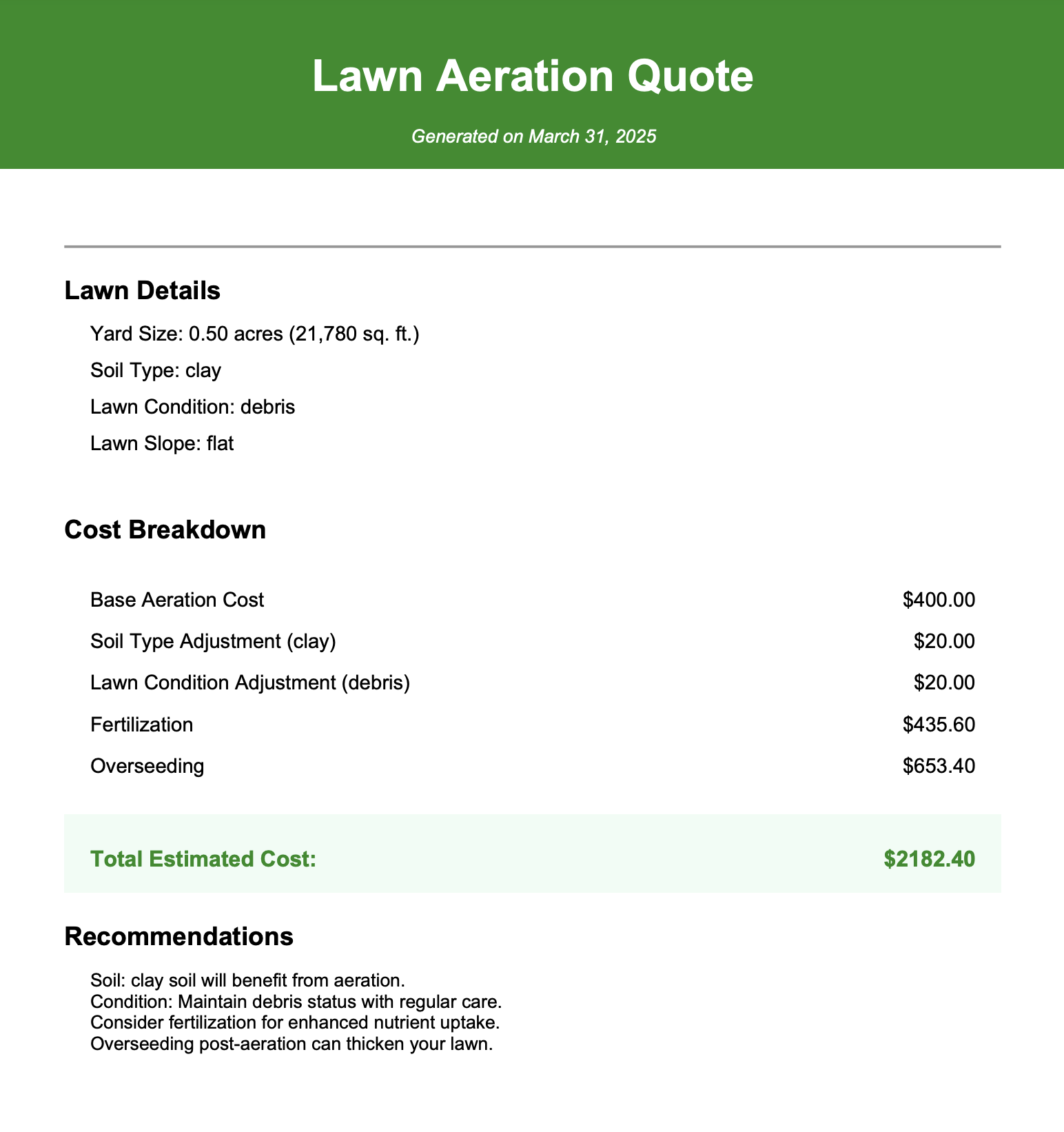Lawn Aeration Cost Calculator | Estimate Your Aeration Price
Lawn Aeration Cost Calculator
Use this lawn aeration cost calculator to get an accurate estimate for aerating your lawn. The calculator factors in yard size, soil type, lawn condition, slope, and optional services like fertilization and seeding. You can even download a professional PDF estimate to share with clients or keep for your records.
Lawn Aeration Cost Calculator
How to Use the Lawn Aeration Cost Calculator
The Lawn Aeration Cost Calculator helps you generate detailed cost estimates and invoices for lawn aeration services. Whether you're a homeowner planning maintenance or a professional creating client quotes, this tool simplifies the process. Follow these steps to create your personalized aeration invoice that helps educate customers about the benefits of this service.
Step-by-Step Guide
Here's how to navigate the calculator and generate your invoice:
1. Enter Property Information (Optional)
Start by naming your property for easy reference. In the "Property Name" field, input a label like "Home" or "Rental Property" to identify the lawn being aerated.
2. Specify Yard Size and Pricing
Provide details about the lawn’s dimensions and cost structure:
- Yard Size: Enter the approximate size (e.g., 5000 sq. ft.). The median yard size in the United States is 0.14 acres according to The Atlantic.
- Size Unit: Choose between "Square Feet" or "Acres."
- Price Per Unit: Set your rate (e.g., $0.08 per sq. ft. or $800 per acre). Typical pricing is $0.15/sq. ft. or $800/acre.
- Price Unit: Select "Per Sq. Ft" or "Per Acre" to match your pricing model.

3. Select Soil Type
Choose the soil type to account for aeration difficulty. Loam is ideal and incurs no additional cost, while hard clay may slightly increase effort and pricing due to its compactness. Rocky soil could require special equipment, potentially affecting costs, and sandy soil might need more frequent aeration. Wet or muddy conditions are not ideal and may come with a premium if aeration is performed.
4. Assess Lawn Condition
Indicate the lawn’s current state, which can influence pricing. A normal lawn uses standard rates, but one with heavy debris might need cleanup first. Weedy lawns could benefit from herbicide treatment, while drought-stressed lawns may require watering beforehand. Thatch-heavy lawns might need dethatching, and those with disease or pest issues could require additional treatments, all potentially adjusting the final cost.
5. Define Lawn Slope
Select the slope to adjust for time and effort. Flat lawns (0-2% slope) have no extra cost, and gentle slopes (2-5%) have minimal impact. Moderate slopes (5-10%) might slightly increase costs due to added difficulty, while steep slopes (10-20%) require more effort and could see a moderate cost increase. Very steep slopes (over 20%) often incur a significant surcharge due to the challenge and time involved.
6. Add Optional Services
Enhance your invoice with additional services:
- Apply Fertilization: Check this box to include fertilizing costs, ideal post-aeration.
- Apply Overseeding: Add seeding costs for optimal growth after aeration.
7. Provide Contact Information (Optional)
Include your details for a professional invoice:
- Name or Business: Your name or company name.
- Email: Contact email (e.g., your@email.com).
- Phone: Phone number (e.g., (123) 456-7890).
- Address: Property or business address.
8. Generate Your Invoice
Click "Calculate Lawn Aeration Cost" to see your estimate:
- Lawn Details: Summarizes size, soil type, condition, and slope.
- Cost Breakdown: Shows base cost and total estimate.
- Recommendations: Offers tailored advice based on inputs.

Tips for Best Results
To get the most out of the tool, use accurate yard measurements for precise estimates and adjust pricing based on local rates or your business model. Including contact information creates a professional-looking invoice, and reviewing the recommendations can help you upsell services like fertilization or overseeding to enhance the lawn’s health and your revenue.
This calculator provides a customizable, detailed estimate you can save as a PDF or share with clients. Experiment with different inputs to see how factors affect pricing. The cost break down section helps make you billing clear to customers on the invoice.
When to Aerate Your Lawn
You will be asked this by customers so be prepared for it. Here's the best time to aerate depending on your grass type:
Cool-Season Grasses
Best time: Early fall or spring
- Kentucky bluegrass
- Fescue
- Ryegrass
Fall aeration allows grass to recover before winter dormancy and prepares it for strong spring growth.
Warm-Season Grasses
Best time: Late spring or early summer
- Bermuda
- Zoysia
- St. Augustine
- Centipede
Aerate when these grasses are actively growing for optimal recovery and results.
Avoid aeration during drought conditions, extremely wet periods, or when grass is dormant. For best results, water your lawn 1-2 days before aeration to soften the soil without making it muddy.
